The extreme points of Latvia are the points on Latvia's land territory that are furthest north, south, east and west. [1]
The extreme points of Latvia are the points on Latvia's land territory that are furthest north, south, east and west. [1]
In 1998 and 1999, in honour of the 80th anniversary of Latvia's independence, four granite sculptures by Vilnis Titāns (1944–2006) were placed near each of Latvia's extreme points. The project was called Latvija saules zīmē, "Latvia in the Sun sign". The names and locations of the individual sculptures are as follows: [1] [2]

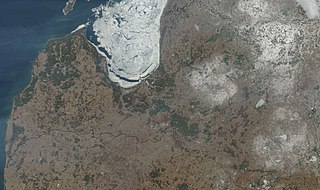
Latvia lies on the eastern shores of the Baltic Sea on the level northwestern part of the rising East European platform, between Estonia and Lithuania. About 98% of the country lies under 200 m (656 ft) elevation. With the exception of the coastal plains, the ice age divided Latvia into three main regions: the morainic Western and Eastern uplands and the Middle lowlands. Latvia holds over 12,000 rivers, only 17 of which are longer than 100 km (60 mi), and over 3,000 small lakes, most of which are eutrophic. The major rivers include the Daugava, the Lielupe, the Gauja, the Venta and the Salaca. Woodlands cover around 52% of the country. Other than peat, dolomite, and limestone, natural resources are scarce. Latvia has 531 km (330 mi) of sandy coastline, and the ports of Liepāja and Ventspils provide important warm-water harbors for the Baltic coast.
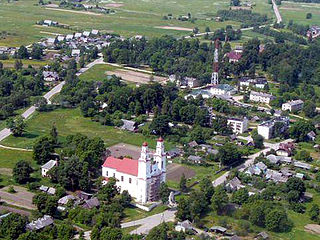
Pasiene is a settlement in Pasiene Parish, Ludza Municipality in the Latgale region of Latvia. It is the easternmost point of Latvia and the easternmost point of the contiguous part of the Baltic States.

The Struve Geodetic Arc is a chain of survey triangulations stretching from Hammerfest in Norway to the Black Sea, through ten countries and over 2,820 kilometres (1,750 mi), which yielded the first accurate measurement of a meridian arc.
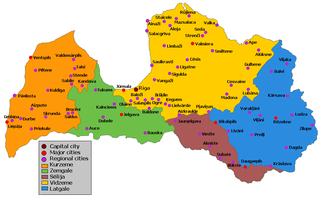
Selonia, also known as Augšzeme, is one of the Historical Latvian Lands encompassing the eastern part of the historical region of Semigallia as well as a portion of northeastern Lithuania. Its main city and cultural center is Jēkabpils. The Selonian language has become extinct, though some of the inhabitants still speak a Latgalian dialect.
This is a list of the extreme points on land of Estonia: the points that are farther north, south, east or west than any other location.

Ludza District was an administrative division of Latvia, located in Latgale region, in the country's east.

Vecsaule Parish is an administrative unit of Bauska Municipality in the Semigallia region of Latvia. Through the parish flows Lambārtes, Iecava and Mēmele River.

Jaunmokas Manor is a manor house in Tume Parish, Tukums Municipality in the historical region of Zemgale, in Latvia. Since 1991 the building has housed a woods and forestry museum, exhibiting the respective techniques and the history of forestry in the country.

Biksēre Manor, also previously known as Libe Manor, is a manor house in the historical region of Vidzeme, in northern Latvia. The estate has a large 14.7-hectare park with 26 sculptures, and an antiques museum has been installed in the stone barn. The manor building currently houses the Sarkaņi parish administrative offices and library.

Burtnieki Castle is a castle in Burtnieki Parish, Valmiera Municipality in the Vidzeme region of Latvia. It was built on the south shore of Lake Burtnieks for the Livonian Order around 1284.
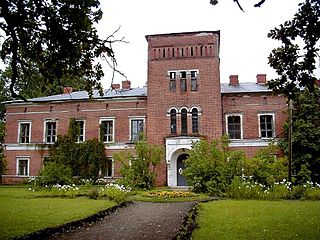
Jumurda Manor is a manor house in Jumurda Parish, Madona Municipality in the Vidzeme region of Latvia. It was built after 1856 in Eclectic style. Vandalized during the Revolution of 1905, the manor was restored in 1907. After 1929 it housed the Jumurda primary school for many years. The estate buildings and manor house are gradually being renovated to create a resort hotel complex.
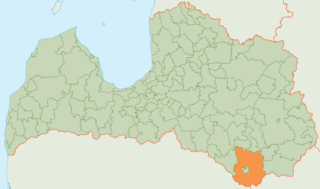
Daugavpils Municipality was a municipality in Latgale, Latvia from 2009 to 2021.

Rūjiena Municipality is a former municipality in Vidzeme, Latvia. The municipality was formed in 2009 by merging Rūjiena town, Ipiķi parish, Jeri parish, Lode parish and Vilpulka parish, the administrative centre being Rūjiena. The population in 2020 was 4,824.
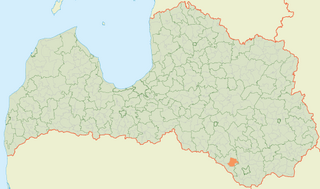
Pilskalne Parish is an administrative unit of Augšdaugava Municipality in the Selonia region of Latvia.

Lielvārde Parish is an administrative unit of Ogre Municipality in the Vidzeme region of Latvia. It was created in 2010 from the countryside territory of Lielvārde town. At the beginning of 2014, the population of the parish was 1033.

Viesīte Parish is an administrative unit of Jēkabpils Municipality in the Selonia region of Latvia. It was created in 2010 from the countryside territory of Viesīte town. At the beginning of 2014, the population of the parish was 704.
Arvīds Brastiņš was a Latvian sculptor, writer and neopagan leader. He was educated at the Saint Petersburg Stieglitz State Academy of Art and Design and began to exhibit his folklore-inspired sculptures in 1918. He worked as a schoolteacher and was active as a writer, writing about Latvian folklore and publishing collections of folksongs. Brastiņš was the brother of Ernests Brastiņš who founded the Baltic neopagan movement Dievturība in the 1920s. Both brothers became major intellectual leaders within this movement. Resettled in the United States after the Soviet occupation of Latvia, Arvīds Brastiņš led an émigré continuation of the movement until his death.

South Kurzeme Municipality is one of the 35 municipalities established in Latvia in 2021. It surrounds Liepāja, Latvia's third largest city. Its first elected municipal council will take office on 1 July 2021. Its seat is at Grobiņa.

Augšdaugava Municipality is one of the 35 municipalities established in Latvia in 2021. It surrounds the independent city of Daugavpils and its municipal headquarters are located there. Its first elected municipal council has taken office on 1 July 2021.
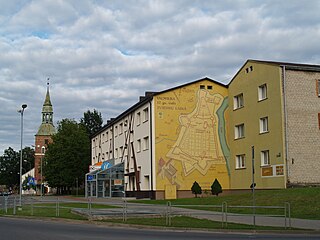
Valmiera Municipality is one of the 35 municipalities established in Latvia in 2021, located approximately 180 kilometres (110 mi) west of the national capital Riga. Its first elected municipal council took office on 1 July 2021. Its seat is the city of Valmiera.